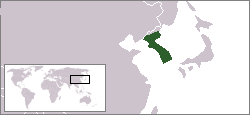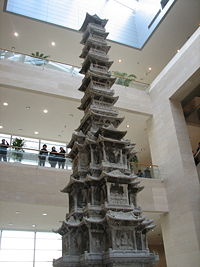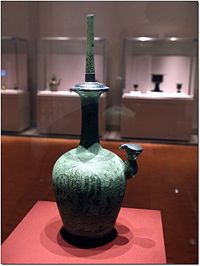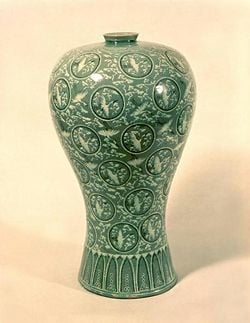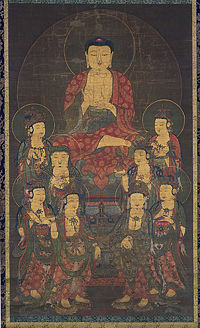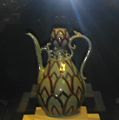Goryeo Dynasty (Korea)
Dan Davies (talk | contribs) (edit) |
|||
| (26 intermediate revisions by 10 users not shown) | |||
| Line 1: | Line 1: | ||
| − | {{ | + | {{approved}}{{submitted}}{{images OK}}{{Paid}}{{Copyedited}} |
| + | {{epname|Goryeo Dynasty (Korea)}} | ||
{{Infobox Former Country | {{Infobox Former Country | ||
|native_name = {{lang|ko|고려국 (高麗國)}}<br /><small>{{lang|ko|고려왕조 (高麗王朝)}}</small> | |native_name = {{lang|ko|고려국 (高麗國)}}<br /><small>{{lang|ko|고려왕조 (高麗王朝)}}</small> | ||
| Line 17: | Line 18: | ||
| | | | ||
|event_start = Coronation of [[Wang Geon|Taejo]] | |event_start = Coronation of [[Wang Geon|Taejo]] | ||
| − | |date_start = June 15 918 | + | |date_start = June 15, 918 |
|event_end = Abdication of [[Gongyang of Goryeo|Gongyang]] | |event_end = Abdication of [[Gongyang of Goryeo|Gongyang]] | ||
| − | |date_end = July 18 1392 | + | |date_end = July 18, 1392 |
| | | | ||
|event1 = [[Goryeo-Khitan Wars|Korea-Khitan Wars]] | |event1 = [[Goryeo-Khitan Wars|Korea-Khitan Wars]] | ||
|date_event1 = 993 - 1019 | |date_event1 = 993 - 1019 | ||
| − | |event2 = [[Mongol invasions of Korea|Mongolian | + | |event2 = [[Mongol invasions of Korea|Mongolian invasions]] |
|date_event2 = 1231 - 1270 | |date_event2 = 1231 - 1270 | ||
|event3 = Completion of [[Tripitaka Koreana]] | |event3 = Completion of [[Tripitaka Koreana]] | ||
| Line 49: | Line 50: | ||
|symbol_type = Taegeuk is a traditional symbol of Korea | |symbol_type = Taegeuk is a traditional symbol of Korea | ||
| | | | ||
| − | |image_map = | + | |image_map = Locationmap_Goryeo.png |
|image_map_caption = | |image_map_caption = | ||
| | | | ||
| Line 77: | Line 78: | ||
|footnotes = | |footnotes = | ||
}} | }} | ||
| − | The '''Goryeo Dynasty''', established in 918, united the [[Later Three Kingdoms]] in 935 and ruled [[Korea]] until replaced by the [[Joseon | + | The '''Goryeo Dynasty''' marks the last Buddhist-shaped dynasty in Korea after 1000 years of political influence. Goryeo, established in 918, united the [[Later Three Kingdoms]] in 935 and ruled [[Korea]] until replaced by the [[Joseon Dynasty]] in 1392. Goryeo pottery—the famous Korean [[celadon]] pottery—and the ''[[Tripitaka Koreana]]''—the [[Korean Buddhism|Buddhist]] scriptures ''([[Tripitaka Koreana |Tripitaka]])'' carved onto roughly 80,000 woodblocks number among Goryeo's outstanding contributions to Korea culture. Goryeo also created the world's first metal-based movable type [[printing press]] in 1234. The name "Goryeo" derives from a shortened form of "[[Goguryeo]]," one of the ancient [[Three Kingdoms Period|Three Kingdoms of Korea]]. The English name "Korea" originates from "Goryeo." |
| − | + | {{toc}} | |
| − | The name "Goryeo" derives from a shortened form of "[[Goguryeo]]," one of the ancient [[Three Kingdoms of Korea]]. The English name "Korea" originates from "Goryeo." | ||
| − | |||
==History== | ==History== | ||
===Background=== | ===Background=== | ||
| − | [[Silla]], which had united the [[Three Kingdoms of Korea]] in 668, weakened and lost control over local lords during the end of the | + | [[Silla]], which had united the [[Three Kingdoms of Korea]] in 668, weakened and lost control over local lords during the end of the ninth century. The country entered a period of civil war and rebellion, led by [[Gung Ye]], [[Gi Hwon]], [[Yang Gil]], and [[Gyeon Hwon]]. |
Gung Ye established Hugoguryeo (meaning "Later [[Goguryeo]]," renamed [[Taebong]]). Gyeon Hwon established [[Hubaekje]] (meaning "Later [[Baekje]]"). Together with the declining Silla, they comprised the [[Later Three Kingdoms of Korea|Later Three Kingdoms]]. | Gung Ye established Hugoguryeo (meaning "Later [[Goguryeo]]," renamed [[Taebong]]). Gyeon Hwon established [[Hubaekje]] (meaning "Later [[Baekje]]"). Together with the declining Silla, they comprised the [[Later Three Kingdoms of Korea|Later Three Kingdoms]]. | ||
| − | + | [[Taejo of Goryeo|Wang Geon]], a lord of Songak (present-day [[Gaesong]]), joined Taebong but overthrew Gung Ye and established Goryeo in 918. [http://unpan1.un.org/intradoc/groups/public/documents/apcity/unpan014460.pdf]. | |
| − | [[Taejo of Goryeo|Wang Geon]], a lord of Songak (present-day [[Gaesong]]), joined Taebong but overthrew Gung Ye and established Goryeo in 918. [http://unpan1.un.org/intradoc/groups/public/documents/apcity/unpan014460.pdf] | + | The [[Later Three Kingdoms]] era ended as Goryeo annexed [[Silla]] in 935 and defeated [[Hubaekje]] in 936. |
| − | The Later Three Kingdoms era ended as Goryeo annexed Silla in 935 and defeated Hubaekje in 936. | + | [[Wang Geon]] moved the capital to his hometown [[Gaeseong]], and ruled the [[Korean Peninsula]] as the first king of Goryeo. |
| − | Wang Geon moved the capital to his hometown Gaeseong, and ruled the Korean | ||
{{History_of_Korea}} | {{History_of_Korea}} | ||
===Political structure=== | ===Political structure=== | ||
The terminology used in the court of Goryeo adopted the system of an empire, not of a kingdom. | The terminology used in the court of Goryeo adopted the system of an empire, not of a kingdom. | ||
| − | Goryeo established the capital in [[Gaesong|Gaeseong]] ("Imperial Capital" (황도, 皇都 | + | Goryeo established the capital in [[Gaesong|Gaeseong]] ("Imperial Capital" (황도, 皇都) and referred to the palace as "Imperial Palace" (황성, 皇城). Other terms, such as "Your (Imperial) Majesty" (폐하, 陛下), "Prince" (태자, 太子), "Empress Dowager" (태후, 太后), and "Imperial Ordinance" (詔 or 勅) also suggest that Goryeo adopted the title system of an empire. Goryeo used the term of an "emperor" (황제, 皇帝) for rulers instead of a [[supreme king]] (대왕, 大王). They sometimes used the term of an "emperor" (황제, 皇帝) or "emperor of the east of the ocean" (해동천자, 海東天子.) [[Mongolia]]n emperors prohibited those terms after the [[Mongol invasion]]. |
| − | To strengthen the power of the central government, [[Gwangjong of Goryeo|Gwangjong]], the fourth supreme king, made a series of laws including that of freeing slaves in 958, and one creating the exam for hiring civil officials. The fifth supreme [[Gyeongjong of Goryeo|king Gyeongjong]] ([[hangul]]: 경종, [[hanja]]: 景宗), launched land-ownership reformation called Jeonsigwa ( | + | To strengthen the power of the central government, [[Gwangjong of Goryeo|Gwangjong]], the fourth supreme king, made a series of laws including that of freeing slaves in 958, and one creating the exam for hiring civil officials. The fifth supreme [[Gyeongjong of Goryeo|king Gyeongjong]] ([[hangul]]: 경종, [[hanja]]: 景宗), launched land-ownership reformation called Jeonsigwa (hangul: 전시과, hanja: 田柴科) and the sixth supreme [[Seongjong of Goryeo|king Seongjong]] (hangul: 성종, hanja: 成宗) appointed officials to local areas previously succeeded by the lords. Between 993 and 1019, the [[Goryeo-Khitan Wars]] ravaged the northern border. |
| − | By the time of eleventh supreme [[Munjong of Goryeo|king Munjong]] ([[hangul]]: 문종, [[hanja]]: 文宗), the central government of Goryeo gained complete authority and power over local lords. | + | By the time of eleventh supreme [[Munjong of Goryeo|king Munjong]] ([[hangul]]: 문종, [[hanja]]: 文宗), the central government of Goryeo gained complete authority and power over local lords. |
| − | Munjong and later supreme kings emphasized the importance of [[civilian control of the military|civilian leadership over the military]]. | + | Munjong and later supreme kings emphasized the importance of [[civilian control of the military|civilian leadership over the military]]. |
| − | |||
== Internal disorder and Wars == | == Internal disorder and Wars == | ||
| Line 108: | Line 105: | ||
:''See main article: [[Goryeo-Khitan Wars]]'' | :''See main article: [[Goryeo-Khitan Wars]]'' | ||
| + | In 993, the [[Liao Dynasty|Khitan]] invaded Goryeo's northwest border with 800,000 troops. The Khitan withdrew and ceded territory to the east of the [[Yalu River]] when Goryeo agreed to end its alliance with [[Song]] China. Goryeo continued to communicate with Song, having strengthened its position by building fortress in the newly gained northern territories. Meanwhile, in 1009, General [[Gang Jo]] of Goryeo led a coup against [[Mokjong of Goryeo|King Mokjong]] killing the king and establishing military rule. In 1010, The [[Khitan]] attacked again during an internal Goryeo power struggle. Gang Jo blocked the Liao invasions until his own death. The Khitan forced Goryeo [[Hyeonjong of Goryeo|king Hyeonjong]] to flee the capital temporarily, but unable to establish a foothold and fearing a counterattack, the Khitan forces withdrew. In 1018, Khitan invaded for a third time. General [[Gang Gamchan]] ordered the stream blocked until the Khitans began to cross it, and the Khitans mid-way across, he ordered the dam destroyed, drowning much of the Khitan army. Khitan's army devastated, General Gang led a massive attack that annihilated all the Khitan army. Barely a few thousand of the Liao troops survived after the bitter defeat at [[Battle of Kwiju|Kwiju]]. | ||
| + | After Gang Gamchan, General [[Yoon Gwan]] destroyed the [[Jurchens]] armies and expanded the Goryeo territory for a temporary time. | ||
| + | ===Power struggles=== | ||
| + | The House [[Yi of Inju]] (인주 이씨, 仁州李氏) married the supreme king from [[Munjong]] into the family of the seventeenth supreme king, [[Injong of Goryeo|Injong]]. Eventually the Yi family gained more power than the supreme king himself. That spawned a coup by [[Yi Ja-gyeom]] in 1126. The coup, although failed, left the monarchy weakened; Goryeo broke out in civil war among the nobility. | ||
| + | In 1135, [[Myo Cheong]] proposed a move of the capital to Seogyeong (present day [[Pyongyang|P'yŏngyang]]). That proposal divided the nobility of Goryeo in half. One faction, led by Myo Cheong, supporting moving the capital to Pyongyang and expanding Goryeo into [[Manchuria]]. The other faction, led by [[Kim Bu-sik]] (author of the ''[[Samguk Sagi]]''), urged resistance to the move, preferring to maintain the present location. Myo Cheong failed to persuade the King. He rebelled against the throne, failed, suffering execution. | ||
| − | In | + | In 1170, a group of army officers led by [[Jeong Jung-bu]] (정중부, 鄭仲夫) and [[Yi Ui-bang]] (이의방, 李義方), launched a [[coup d'état]] and succeeded to overthrow the crown. They sent [[Injong of Goryeo|supreme king Injong]] into exile, installing [[Myeongjong of Goryeo|supreme king Myeongjong]] (명종,明宗) as king. Effective power, though, lay with a succession of generals: military rule of Goryeo had begun. In 1177, the young general [[Kyong Taesung]] rose to power, attempting to restore the full power of the monarch while purging the corruption of the state. He died in 1184 before he could bring about reform. [[Yi Ui-min]], the son of a slave, succeeded him. His unrestrained corruption and cruelty spawned a coup by a more traditionalist general, [[Choi Chungheon]], who assassinated [[Yi Uimin]] and took over power in 1197. For the next 61 years, the Choe house ruled as military dictators, maintaining the kings as puppet monarchs. |
| − | + | Choe Chungheon's son [[Choi U]], his grandson [[Choi Hang]] and his great-grandson [[Choi Ui]] succeeded in turn. On taking power, Choi Chungheon forced Meyongjong off the throne, replacing him with [[Sinjong of Goryeo|Supreme king Sinjong]]. After Sinjong died, Choi forced the next two kings off the throne until he found the pliable [[Gojong of Goryeo|king Gojong]]. | |
| − | === | + | ===Mongol invasions (1231 - 1259)=== |
| − | + | [[Image:Goryeo Pagoda.jpg|200px|right|thumb|reconstructed Goryeo pagoda]] | |
| + | :''See main article: [[Mongol invasions of Korea]]'' | ||
| + | In 1231, Mongolians under [[Ögedei Khan]] invaded Goryeo as part of a general [[Yuan Dynasty#Northern Conquest|campaign to conquer China]]. The royal court moved to [[Ganghwa Island]] in the [[Bay of Gyeonggi]] in 1232. The military ruler, [[Choe Chung-heon]] (최충헌, 崔忠獻), insisted on fighting back. Goryeo resisted for about 30 years but finally sued for peace in 1259. | ||
| − | + | Meanwhile, the Mongols began a campaign ravaging parts of [[Gyeongsang]] and [[Jeolla]] Provinces. Civilian resistance proved strong, and the Imperial Court at Ganghwa attempted to strengthen its fortress. Korea won several victories but the Korean military faltered in the face of repeated waves of invasions. In 1236, [[Gojong of Goryeo|Gojong]] ordered the re-creation of the [[Tripitaka Koreana]], destroyed during the 1232 invasion. That collection of [[Buddhism|Buddhist]] [[scriptures]], which took fifteen years to carve on some 81,000 wooden blocks, has been housed in Haeinsa since the 1200s. | |
| − | + | [[Kim Jun]] assassinated the dictator Choi in March 1258, ending the military dictatorship. The scholar faction that had insisted peace with Mongol gained power, eventually sending an envoy to [[Mongol]] to negotiate a peace treaty with the Mongols.<ref> 국방부 군사편찬연구소, 고려시대 군사 전략 (2006) (The Ministry of National Defense, Military Strategies in Goryeo)</ref> Military officials who refused to surrender formed the [[Sambyeolcho Rebellion]], resisting in the islands off the southern shore of the [[Korean peninsula]]. The treaty permitted Goryeo sovereign power and practice of traditional cultures, implying that the Mongols settled for less than complete victory.<ref>국사편찬위원회, 고등학교국사교과서 , 63 (National Institute of Korean History, History for High School Students, 64)[http://www.e-history.go.kr/book/index.htm]. </ref> | |
| − | + | Following the peace treaty, the Mongols planned to attack Japan by allying Goryeo troops. The invasion failed during a horrific storm called by the Japanese the [[Kamikaze]] (Japanese: 神風), ''Divine Wind.'' | |
| − | |||
| − | |||
| − | |||
| − | === | + | ===Decline and fall of Goryeo=== |
[[Image:Ddol-mangC.jpg|200px|left|thumb|bronze ritual vessel]] | [[Image:Ddol-mangC.jpg|200px|left|thumb|bronze ritual vessel]] | ||
| − | + | The Mongol [[Yuan Dynasty]] dominated Goryeo when [[Gongmin of Goryeo|King Gongmin]] took over the throne. Forced to spend many years in the Yuan court, sent there in 1341 as a virtual prisoner before becoming a king, he married the Mongol princess [[Nogukdaejang Gongju]] (노국대장공주, 魯國大長公主). In the mid-fourteenth century Yuan dynasty began to crumble, soon replaced by the [[Ming dynasty]] in 1368. Gongmin attempted to reform the Goryeo government. In his first royal act, he removed all pro-[[Mongol]] aristocrats and military officers from their positions. King Gongmin followed that by attacking the Yuan. | |
| − | + | Mongols had annexed the northern provinces of Korea after the invasions, incorporating them into their empire as [[South Hamgyong|Ssangseong]] (쌍성총관부, 雙城摠管府) and [[North Pyongan|Dongnyeong]] (동녕부, 東寧府). The Goryeo army retook those provinces with the help of defector [[Yi Ja-chun]], a minor Korean official in service of Mongols in Ssangseong, and his son [[Yi Seonggye]]. The campaigns of General Yi Seonggye and [[Ji Yongsu]] in [[Liaoyang]] also proved a major factor in the victory. Following the death of his wife, Nogukdaejang Gongju in 1365, [[Gongmin of Goryeo|King Gongmin]] became consumed with grief, losing his interest in the affairs of state, entrusting the throne to a monk [[Shin Don]] (신돈, 辛旽). Shin Don ruled for six years until killed by a court official close to him. From that time, Goryeo quickly slid toward collapse. | |
| − | In 1388, [[U of Goryeo|King U]] and general [[Choe Yeong]] planned a campaign to invade present-day [[Liaoning]] of China. King U put | + | |
| + | In 1388, [[U of Goryeo|King U]] and general [[Choe Yeong]] planned a campaign to invade present-day [[Liaoning]] of China. King U put general [[Taejo of Joseon|Yi Seong-gye]] (later Taejo) in command, but he stopped at the border and rebelled. Goryeo fell to General Yi in 1392. He then established the [[Joseon Dynasty]]. | ||
==Culture== | ==Culture== | ||
| − | [[Image: | + | [[Image:Goryeo Celadon .jpg|thumb|right|250px|[[National treasures of South Korea|National Treasure #68]]]] |
| + | |||
===Tripitaka Koreana=== | ===Tripitaka Koreana=== | ||
| + | ''Main Article:'' [[Tripitaka Koreana]] | ||
| + | |||
| + | The [[Tripitaka Koreana]], also known as the "[[Goryeo]] ''Tripitaka,''" is a Korean collection of the ''Tripitaka'' (Buddhist scriptures, and the Sanskrit word for "three baskets") stored in [[Haeinsa]]. During the [[Mongol invasions of Korea]] in 1231, the Mongols destroyed the original set of woodblocks. When the capital of Goryeo was moved to [[Ganghwa Island]] during nearly three decades of Mongol attacks, King Gojong of Goryeo ordered the recarving of the Tripitaka. Carved into wood blocks, the Tripitaka displayed a technology far surpassing that of the time. Buddhist scholars consider the Tripitaka Koreana the best preserved and most complete extant version of Buddhist canon in Chinese script. | ||
| + | |||
===Goryeo celadon=== | ===Goryeo celadon=== | ||
| − | [[ | + | ''Main Article'': [[Korean pottery and porcelain]] |
| + | The celadon wares of the [[Goryeo]] Dynasty have been deemed among the finest ever crafted in any period of Korean history. Elaborate and intricate designs grace the celadon, glazed in a variety of colors. Bottles, bowls, cosmetic boxes, cups, vases with lotus motifs and lotus flower heads present a marvel to the artistic eye. | ||
| + | |||
===Buddhism=== | ===Buddhism=== | ||
| − | :'' | + | ''Main Article:'' [[Korean Buddhism]]'' |
| + | [[Image:Goryeo Buddhist painting.jpg|thumb|right|200px|''Amitabha and Eight Great Bodhisattvas,'' Goryeo scroll from the 1300s]] | ||
| + | The [[Seon]] schools of the "nine mountain" monasteries, after a struggle with other forms of Buddhism, became the dominate branch of [[Buddhism]] in Goryeo. Seon exerted enormous influence on the court and society, producing scholars and saints. During the Goryeo period, Seon thoroughly became a "religion of the state," receiving extensive support and privileges through connections with the ruling family and powerful members of the court. | ||
| − | == | + | The [[Hwaeom]] school, also, served as a vibrant branch of [[Buddhism]] during the Goryeo dynasty, especially through the work of '''Gyunyeo''' (均如; 923-973) who prepared for the reconciliation of Hwaeom and Seon. [[Jinul]] (知訥; 1158-1210) has earned the accolade of the most important figure of Seon in the Goryeo. Buddhism had gradually become corrupted by influences that diluted the impact of the Buddhist practice: fortune-telling, offering of prayers and rituals for success in secular endeavors. Jinul established a new movement within Korean Seon called the ''"[[samadhi|samādhi]] and [[prajña|prajñā]] society,"'' founding of the Seonggwangsa monastery at Mount [[Jogye]] (曹溪山). Jinul's philosophical resolution of the Seon-Gyo conflict brought a deep and lasting effect on [[Korean Buddhism]]. |
| + | |||
| + | [[Buddhism]] declined in the latter half of the Goryeo due to corruption and the rise of strong anti-Buddhist political and philosophical sentiment. Even so, three important monks of that period advanced Korean [[Seon]]: [[Gyeonghan Baeg'un]] (景閑白雲; 1298-1374), [[Taego Bou]] (太古普愚; 1301-1382) and [[Naong Hyegeun]] (懶翁慧勤; 1320-1376). [[Gyeonghan]] and [[Naong]], under the influence of Jinul and the traditional [[tong bulgyo]] tendency, showed an unusual interest in scriptural study, as well as a strong understanding of [[Confucianism]] and [[Daoism]], introduced a tread for Korean Buddhist monks to teach "three teachings." | ||
| + | |||
| + | == Gallery == | ||
| + | <Gallery> | ||
| + | Image:Ddol-mangI.jpg|Bronze Mirrors | ||
| + | Image:IMG 0291 ko.JPG|Koryo Period Pressed Designs Bowl, Private Collection | ||
| + | Image:Iloveconor.com6.jpg|Incense Burner | ||
| + | <!--Image:Goryeo Celadon .jpg|[[National treasures of South Korea|National Treasure #68]]—> | ||
| + | <!--Image:Xcoldricex6.jpg|Celadon incense burner, Goryeo Dynasty. [[National treasures of South Korea|National Treasure]] currently preserved in [[National Museum of Korea]].—> | ||
| + | Image:Korean Wine Ewer.jpg|Korean wine ewer, Goryeo Dynasty, c. 1250 C.E. | ||
| + | </Gallery> | ||
| + | |||
| + | ==Notes== | ||
<references/> | <references/> | ||
| − | == | + | == References == |
| − | * | + | * Kim, Kumja P. ''Goryeo dynasty: Korea's age of enlightenment, 918-1392.'' San Francisco: Asian Art Museum—Chong-Moon Lee Center for Asian Art and Culture in cooperation with the National Museum of Korea and the Nara National Museum, 2003. ISBN 978-0939117253 |
| − | *[ | + | * Kungnip Chungang Pangmulgwan (Korea). Hanʼguk chŏntʻong munyang. 2. Koryŏ chʻŏngja = Goryeo celadon. Sŏul Tʻŭkpyŏlsi: Hanʼguk Pangmulgwanhoe, 2001. |
| − | + | * Yunesŭkʻo Hanʼguk Wiwŏnhoe. ''Korean history: discovery of its characteristics and developments.'' Anthology of Korean studies, Vol. 5. Elizabeth, NJ: Hollym, 2004. ISBN 978-1565911772 | |
| − | *[ | + | |
| − | *[ | + | == External Links == |
| + | All links retrieved June 26, 2017. | ||
| + | *[http://www.san-shin.org/GoryeoArt.html Artworks from the Goryeo Dynasty from an exhibition of North Korean Artifacts at the National Museum of Korea, Seoul Summer 2006]. | ||
| + | *[http://www.asianart.com/exhibitions/korea/intro.html Goryeo Dynasty: Korea's Age of Enlightenment, 918-1392]. | ||
| + | *[http://www.asianart.com/exhibitions/korea/index.html#2 Images Asian Art Museum, San Francisco, October 18, 2003 - January 11, 2004]. | ||
| − | [[Category: | + | [[Category:History]] |
| + | [[Category:Korea]] | ||
{{credits|127170046}} | {{credits|127170046}} | ||
Latest revision as of 18:12, 26 December 2022
| |||||||||||||||||||||||||||||||||||||||||||||
The Goryeo Dynasty marks the last Buddhist-shaped dynasty in Korea after 1000 years of political influence. Goryeo, established in 918, united the Later Three Kingdoms in 935 and ruled Korea until replaced by the Joseon Dynasty in 1392. Goryeo pottery—the famous Korean celadon pottery—and the Tripitaka Koreana—the Buddhist scriptures (Tripitaka) carved onto roughly 80,000 woodblocks number among Goryeo's outstanding contributions to Korea culture. Goryeo also created the world's first metal-based movable type printing press in 1234. The name "Goryeo" derives from a shortened form of "Goguryeo," one of the ancient Three Kingdoms of Korea. The English name "Korea" originates from "Goryeo."
History
Background
Silla, which had united the Three Kingdoms of Korea in 668, weakened and lost control over local lords during the end of the ninth century. The country entered a period of civil war and rebellion, led by Gung Ye, Gi Hwon, Yang Gil, and Gyeon Hwon.
Gung Ye established Hugoguryeo (meaning "Later Goguryeo," renamed Taebong). Gyeon Hwon established Hubaekje (meaning "Later Baekje"). Together with the declining Silla, they comprised the Later Three Kingdoms.
Wang Geon, a lord of Songak (present-day Gaesong), joined Taebong but overthrew Gung Ye and established Goryeo in 918. [2]. The Later Three Kingdoms era ended as Goryeo annexed Silla in 935 and defeated Hubaekje in 936. Wang Geon moved the capital to his hometown Gaeseong, and ruled the Korean Peninsula as the first king of Goryeo.
|
Jeulmun Period
|
Political structure
The terminology used in the court of Goryeo adopted the system of an empire, not of a kingdom. Goryeo established the capital in Gaeseong ("Imperial Capital" (황도, 皇都) and referred to the palace as "Imperial Palace" (황성, 皇城). Other terms, such as "Your (Imperial) Majesty" (폐하, 陛下), "Prince" (태자, 太子), "Empress Dowager" (태후, 太后), and "Imperial Ordinance" (詔 or 勅) also suggest that Goryeo adopted the title system of an empire. Goryeo used the term of an "emperor" (황제, 皇帝) for rulers instead of a supreme king (대왕, 大王). They sometimes used the term of an "emperor" (황제, 皇帝) or "emperor of the east of the ocean" (해동천자, 海東天子.) Mongolian emperors prohibited those terms after the Mongol invasion.
To strengthen the power of the central government, Gwangjong, the fourth supreme king, made a series of laws including that of freeing slaves in 958, and one creating the exam for hiring civil officials. The fifth supreme king Gyeongjong (hangul: 경종, hanja: 景宗), launched land-ownership reformation called Jeonsigwa (hangul: 전시과, hanja: 田柴科) and the sixth supreme king Seongjong (hangul: 성종, hanja: 成宗) appointed officials to local areas previously succeeded by the lords. Between 993 and 1019, the Goryeo-Khitan Wars ravaged the northern border.
By the time of eleventh supreme king Munjong (hangul: 문종, hanja: 文宗), the central government of Goryeo gained complete authority and power over local lords. Munjong and later supreme kings emphasized the importance of civilian leadership over the military.
Internal disorder and Wars
Khitan invasions (993 - 1019)
- See main article: Goryeo-Khitan Wars
In 993, the Khitan invaded Goryeo's northwest border with 800,000 troops. The Khitan withdrew and ceded territory to the east of the Yalu River when Goryeo agreed to end its alliance with Song China. Goryeo continued to communicate with Song, having strengthened its position by building fortress in the newly gained northern territories. Meanwhile, in 1009, General Gang Jo of Goryeo led a coup against King Mokjong killing the king and establishing military rule. In 1010, The Khitan attacked again during an internal Goryeo power struggle. Gang Jo blocked the Liao invasions until his own death. The Khitan forced Goryeo king Hyeonjong to flee the capital temporarily, but unable to establish a foothold and fearing a counterattack, the Khitan forces withdrew. In 1018, Khitan invaded for a third time. General Gang Gamchan ordered the stream blocked until the Khitans began to cross it, and the Khitans mid-way across, he ordered the dam destroyed, drowning much of the Khitan army. Khitan's army devastated, General Gang led a massive attack that annihilated all the Khitan army. Barely a few thousand of the Liao troops survived after the bitter defeat at Kwiju.
After Gang Gamchan, General Yoon Gwan destroyed the Jurchens armies and expanded the Goryeo territory for a temporary time.
Power struggles
The House Yi of Inju (인주 이씨, 仁州李氏) married the supreme king from Munjong into the family of the seventeenth supreme king, Injong. Eventually the Yi family gained more power than the supreme king himself. That spawned a coup by Yi Ja-gyeom in 1126. The coup, although failed, left the monarchy weakened; Goryeo broke out in civil war among the nobility.
In 1135, Myo Cheong proposed a move of the capital to Seogyeong (present day P'yŏngyang). That proposal divided the nobility of Goryeo in half. One faction, led by Myo Cheong, supporting moving the capital to Pyongyang and expanding Goryeo into Manchuria. The other faction, led by Kim Bu-sik (author of the Samguk Sagi), urged resistance to the move, preferring to maintain the present location. Myo Cheong failed to persuade the King. He rebelled against the throne, failed, suffering execution.
In 1170, a group of army officers led by Jeong Jung-bu (정중부, 鄭仲夫) and Yi Ui-bang (이의방, 李義方), launched a coup d'état and succeeded to overthrow the crown. They sent supreme king Injong into exile, installing supreme king Myeongjong (명종,明宗) as king. Effective power, though, lay with a succession of generals: military rule of Goryeo had begun. In 1177, the young general Kyong Taesung rose to power, attempting to restore the full power of the monarch while purging the corruption of the state. He died in 1184 before he could bring about reform. Yi Ui-min, the son of a slave, succeeded him. His unrestrained corruption and cruelty spawned a coup by a more traditionalist general, Choi Chungheon, who assassinated Yi Uimin and took over power in 1197. For the next 61 years, the Choe house ruled as military dictators, maintaining the kings as puppet monarchs.
Choe Chungheon's son Choi U, his grandson Choi Hang and his great-grandson Choi Ui succeeded in turn. On taking power, Choi Chungheon forced Meyongjong off the throne, replacing him with Supreme king Sinjong. After Sinjong died, Choi forced the next two kings off the throne until he found the pliable king Gojong.
Mongol invasions (1231 - 1259)
- See main article: Mongol invasions of Korea
In 1231, Mongolians under Ögedei Khan invaded Goryeo as part of a general campaign to conquer China. The royal court moved to Ganghwa Island in the Bay of Gyeonggi in 1232. The military ruler, Choe Chung-heon (최충헌, 崔忠獻), insisted on fighting back. Goryeo resisted for about 30 years but finally sued for peace in 1259.
Meanwhile, the Mongols began a campaign ravaging parts of Gyeongsang and Jeolla Provinces. Civilian resistance proved strong, and the Imperial Court at Ganghwa attempted to strengthen its fortress. Korea won several victories but the Korean military faltered in the face of repeated waves of invasions. In 1236, Gojong ordered the re-creation of the Tripitaka Koreana, destroyed during the 1232 invasion. That collection of Buddhist scriptures, which took fifteen years to carve on some 81,000 wooden blocks, has been housed in Haeinsa since the 1200s.
Kim Jun assassinated the dictator Choi in March 1258, ending the military dictatorship. The scholar faction that had insisted peace with Mongol gained power, eventually sending an envoy to Mongol to negotiate a peace treaty with the Mongols.[1] Military officials who refused to surrender formed the Sambyeolcho Rebellion, resisting in the islands off the southern shore of the Korean peninsula. The treaty permitted Goryeo sovereign power and practice of traditional cultures, implying that the Mongols settled for less than complete victory.[2]
Following the peace treaty, the Mongols planned to attack Japan by allying Goryeo troops. The invasion failed during a horrific storm called by the Japanese the Kamikaze (Japanese: 神風), Divine Wind.
Decline and fall of Goryeo
The Mongol Yuan Dynasty dominated Goryeo when King Gongmin took over the throne. Forced to spend many years in the Yuan court, sent there in 1341 as a virtual prisoner before becoming a king, he married the Mongol princess Nogukdaejang Gongju (노국대장공주, 魯國大長公主). In the mid-fourteenth century Yuan dynasty began to crumble, soon replaced by the Ming dynasty in 1368. Gongmin attempted to reform the Goryeo government. In his first royal act, he removed all pro-Mongol aristocrats and military officers from their positions. King Gongmin followed that by attacking the Yuan.
Mongols had annexed the northern provinces of Korea after the invasions, incorporating them into their empire as Ssangseong (쌍성총관부, 雙城摠管府) and Dongnyeong (동녕부, 東寧府). The Goryeo army retook those provinces with the help of defector Yi Ja-chun, a minor Korean official in service of Mongols in Ssangseong, and his son Yi Seonggye. The campaigns of General Yi Seonggye and Ji Yongsu in Liaoyang also proved a major factor in the victory. Following the death of his wife, Nogukdaejang Gongju in 1365, King Gongmin became consumed with grief, losing his interest in the affairs of state, entrusting the throne to a monk Shin Don (신돈, 辛旽). Shin Don ruled for six years until killed by a court official close to him. From that time, Goryeo quickly slid toward collapse.
In 1388, King U and general Choe Yeong planned a campaign to invade present-day Liaoning of China. King U put general Yi Seong-gye (later Taejo) in command, but he stopped at the border and rebelled. Goryeo fell to General Yi in 1392. He then established the Joseon Dynasty.
Culture
Tripitaka Koreana
Main Article: Tripitaka Koreana
The Tripitaka Koreana, also known as the "Goryeo Tripitaka," is a Korean collection of the Tripitaka (Buddhist scriptures, and the Sanskrit word for "three baskets") stored in Haeinsa. During the Mongol invasions of Korea in 1231, the Mongols destroyed the original set of woodblocks. When the capital of Goryeo was moved to Ganghwa Island during nearly three decades of Mongol attacks, King Gojong of Goryeo ordered the recarving of the Tripitaka. Carved into wood blocks, the Tripitaka displayed a technology far surpassing that of the time. Buddhist scholars consider the Tripitaka Koreana the best preserved and most complete extant version of Buddhist canon in Chinese script.
Goryeo celadon
Main Article: Korean pottery and porcelain The celadon wares of the Goryeo Dynasty have been deemed among the finest ever crafted in any period of Korean history. Elaborate and intricate designs grace the celadon, glazed in a variety of colors. Bottles, bowls, cosmetic boxes, cups, vases with lotus motifs and lotus flower heads present a marvel to the artistic eye.
Buddhism
Main Article: Korean Buddhism
The Seon schools of the "nine mountain" monasteries, after a struggle with other forms of Buddhism, became the dominate branch of Buddhism in Goryeo. Seon exerted enormous influence on the court and society, producing scholars and saints. During the Goryeo period, Seon thoroughly became a "religion of the state," receiving extensive support and privileges through connections with the ruling family and powerful members of the court.
The Hwaeom school, also, served as a vibrant branch of Buddhism during the Goryeo dynasty, especially through the work of Gyunyeo (均如; 923-973) who prepared for the reconciliation of Hwaeom and Seon. Jinul (知訥; 1158-1210) has earned the accolade of the most important figure of Seon in the Goryeo. Buddhism had gradually become corrupted by influences that diluted the impact of the Buddhist practice: fortune-telling, offering of prayers and rituals for success in secular endeavors. Jinul established a new movement within Korean Seon called the "samādhi and prajñā society," founding of the Seonggwangsa monastery at Mount Jogye (曹溪山). Jinul's philosophical resolution of the Seon-Gyo conflict brought a deep and lasting effect on Korean Buddhism.
Buddhism declined in the latter half of the Goryeo due to corruption and the rise of strong anti-Buddhist political and philosophical sentiment. Even so, three important monks of that period advanced Korean Seon: Gyeonghan Baeg'un (景閑白雲; 1298-1374), Taego Bou (太古普愚; 1301-1382) and Naong Hyegeun (懶翁慧勤; 1320-1376). Gyeonghan and Naong, under the influence of Jinul and the traditional tong bulgyo tendency, showed an unusual interest in scriptural study, as well as a strong understanding of Confucianism and Daoism, introduced a tread for Korean Buddhist monks to teach "three teachings."
Gallery
Notes
ReferencesISBN links support NWE through referral fees
- Kim, Kumja P. Goryeo dynasty: Korea's age of enlightenment, 918-1392. San Francisco: Asian Art Museum—Chong-Moon Lee Center for Asian Art and Culture in cooperation with the National Museum of Korea and the Nara National Museum, 2003. ISBN 978-0939117253
- Kungnip Chungang Pangmulgwan (Korea). Hanʼguk chŏntʻong munyang. 2. Koryŏ chʻŏngja = Goryeo celadon. Sŏul Tʻŭkpyŏlsi: Hanʼguk Pangmulgwanhoe, 2001.
- Yunesŭkʻo Hanʼguk Wiwŏnhoe. Korean history: discovery of its characteristics and developments. Anthology of Korean studies, Vol. 5. Elizabeth, NJ: Hollym, 2004. ISBN 978-1565911772
External Links
All links retrieved June 26, 2017.
- Artworks from the Goryeo Dynasty from an exhibition of North Korean Artifacts at the National Museum of Korea, Seoul Summer 2006.
- Goryeo Dynasty: Korea's Age of Enlightenment, 918-1392.
- Images Asian Art Museum, San Francisco, October 18, 2003 - January 11, 2004.
Credits
New World Encyclopedia writers and editors rewrote and completed the Wikipedia article in accordance with New World Encyclopedia standards. This article abides by terms of the Creative Commons CC-by-sa 3.0 License (CC-by-sa), which may be used and disseminated with proper attribution. Credit is due under the terms of this license that can reference both the New World Encyclopedia contributors and the selfless volunteer contributors of the Wikimedia Foundation. To cite this article click here for a list of acceptable citing formats.The history of earlier contributions by wikipedians is accessible to researchers here:
The history of this article since it was imported to New World Encyclopedia:
Note: Some restrictions may apply to use of individual images which are separately licensed.

